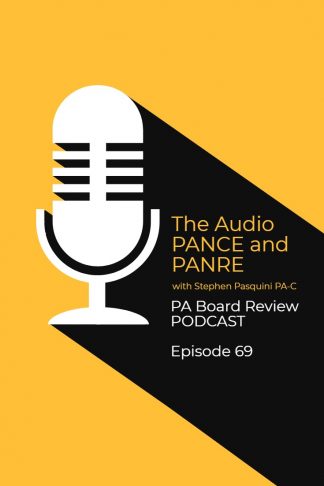Podcast: Play in new window | Download
Subscribe: Apple Podcasts | RSS

The Audio PANCE/PANRE Board Review Exam Questions
Welcome to episode 69 of the Audio PANCE and PANRE PA Board Review Podcast.
Join me as I cover ten PANCE and PANRE Board review questions from the SMARTYPANCE course content following the NCCPA™ content blueprint (download the FREE cheat sheet).
This week we will be covering ten general board review questions based on the NCCPA PANCE and PANRE Content Blueprints.
Below you will find an interactive exam to complement the podcast.
I hope you enjoy this free audio component to the examination portion of this site. The full board review includes over 2,000 interactive board review questions and is available to all members of the PANCE and PANRE Academy and Smarty PANCE.
- You can download and listen to past FREE episodes here, on iTunes, on Google Play Music or Stitcher Radio.
- You can listen to the latest episode, take an interactive quiz and download your results below.
Listen Carefully Then Take The Practice Exam
If you can’t see the audio player click here to listen to the full episode.
Podcast Episode 69: 10 Question PANCE and PANRE Podcast Quiz
The following questions are linked to NCCPA Content Blueprint lessons from the Smarty PANCE and PANRE Board Review Website. If you are a member you will be able to log in and view this interactive video lesson.
1. Which of the following is the most common cause of acute myocardial infarction?
A. Occlusion caused by coronary microemboli
B. Thrombus development at a site of vascular injury
C. Congenital abnormalities
D. Severe coronary artery spasm
2. Endotracheal intubation should be performed with caution in patients with which of the following underlying conditions due to the propensity to cause subluxation of C1 on C2?
A. Rheumatoid arthritis
B. Osteoarthritis
C. Gout
D. Pseudogout
3. Which of the following interventions is the treatment of choice for an actinic keratosis?
A. Mohs surgery
B. Cryotherapy
C. Acid peels
D. Radiation therapy
4. A 55-year-old secretary presents with ongoing pain and numbness in her hand. These symptoms are worse at night and she must shake her hand to regain feeling in it. Which of the following physical examination signs will be
present?
A. Hypothenar atrophy
B. Weakness of finger abduction
C. Inability to maintain wrist extension against resistance
D. Weakness of thumb abduction
5. A 78-year-old male with history of coronary artery disease status post-CABG and ischemic cardiomyopathy presents with a complaint of progressive dyspnea and orthopnea. He also complains of lower extremity edema. The patient denies fever, chest pain, or cough. On physical examination, vital signs are BP 120/68, HR 75 and regular, RR 22, afebrile. You note the patient to have an S3 heart sound, jugular venous distention, and 2+ lower extremity edema. The patient is admitted and treated. Upon discharge from the hospital, the patient should be educated to monitor which of the following at home?
A. Daily weights
B. Daily spirometry
C. Daily blood glucose
D. Daily fat intake
6. Which of the following rotator cuff tendons is most likely to sustain injury because of its repeated impingement (carpal tunnel syndrome) between the humeral head and the undersurface of the anterior third of the acromion and coracoacromial ligament?
A. Supraspinatus
B. Infraspinatus
C. Teres minor
D. Subscapularis
7. Which of the following diagnostic findings in the urinary sediment is specific for a diagnosis of chronic renal failure?
A. Hematuria
B. Proteinuria
C. Broad waxy casts
D. Hyaline casts
8. In addition to tobacco products, which of the following is also considered a major risk factor in the development of oral cancer?
A. Sun exposure
B. Alcohol abuse
C. Occupational exposure
D. History of oral candidiasis
9. A 13-year-old boy with leukemia presents with epistaxis for 2 hours. The bleeding site appears to be from Kiesselbach’s area. The most appropriate intervention is
A. electrocautery of the bleeding site
B. silver nitrate application
C. posterior nasal packing
D. intranasal petrolatum gauze
10. A 2-year-old female presents with purulent nasal discharge bilaterally with fever and cough for several days. Her mom had taken her out of daycare for a similar occurrence 2 months ago, that was treated with Amoxicillin. Exam further reveals halitosis and periorbital edema. Treatment should be initiated with which of the following?
A. Antihistamines
B. Ribavirin (Rebetol)
C. Intranasal corticosteroids
D. Amoxicillin-clavulanate (Augmentin)
Looking for all the podcast episodes?
This FREE series is limited to every other episode, you can download and enjoy the complete audio series by joining The PANCE and PANRE Exam Academy + SMARTYPANCE
I will be releasing new episodes every few weeks. The Academy is discounted, so sign up now.
Resources and Links From The Show
- My list of recommended PANCE and PANRE review books
- Download the FREE PANCE and PANRE Blueprint Checklist
- Sign up for the FREE daily PANCE and PANRE email series
- Join the Smarty PANCE NCCPA Content Blueprint Website + The PA Life Academy
- Get 20% of any Picmonic membership by using this link
- Use Code “PALIFE” and get 10% OFF THE RUTGERS PANCE AND PANRE REVIEW COURSE
This Podcast is also available on iTunes and Stitcher Radio for Android
- iTunes: The Audio PANCE AND PANRE Podcast iTunes
- Stitcher Radio: The Audio PANCE and PANRE Podcast Stitcher

Download The Content Blueprint Checklist
Follow this link to download your FREE copy of the Content Blueprint Checklist
Print it up and start crossing out the topics you understand, marking the ones you don’t and making notes of key terms you should remember. The PDF version is interactive and linked directly to the individual lessons on SMARTY PANCE.
Download for PANCE Download for PANRE

